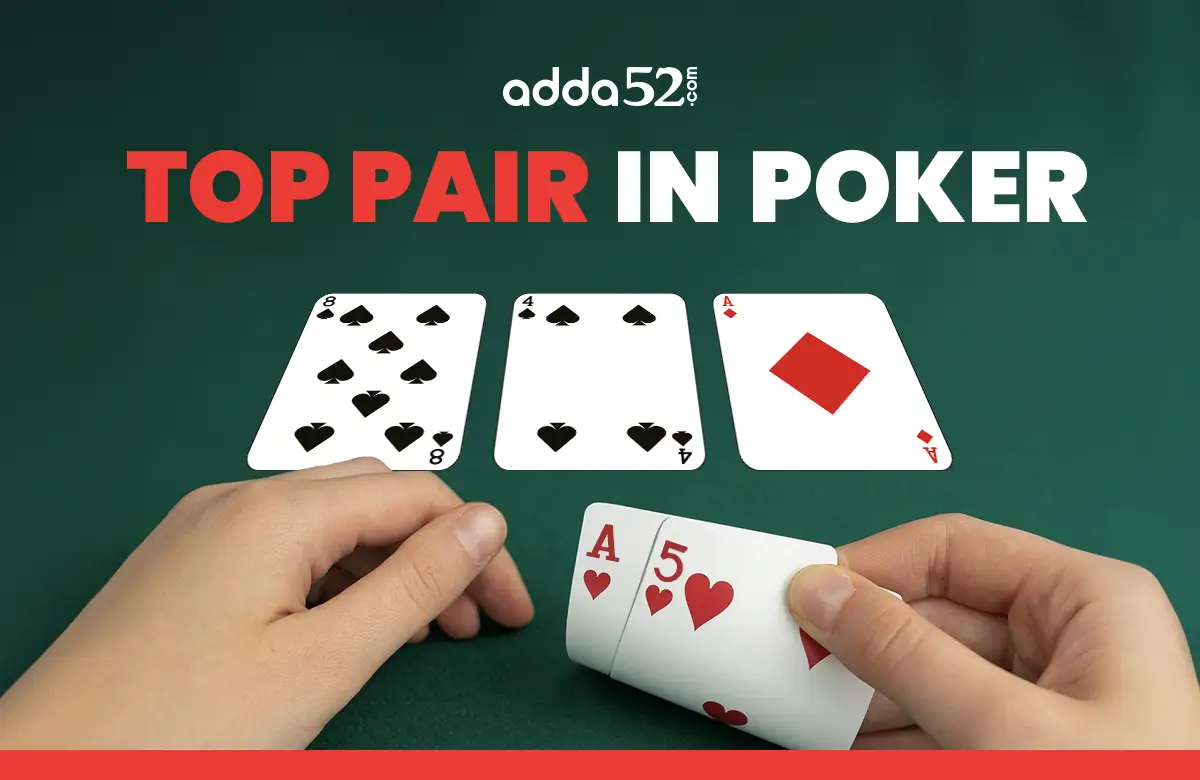
Introduction
Top Pair is a solid hand that often gives you the lead in the pot, but it’s also a hand that requires careful management. It is one of the most common yet critical hands you will encounter, as it tests your ability to balance aggression with caution.
Here's everything you need to know about top pairs in Poker:
Understanding Top Pair
The top pair is a common hand that refers to the best pair that can be made from the community cards in relation to your hole cards. For example:
- If the community cards are 10♠, 7♦, 3♣, and you have a 10♥ in your hand, you have the top pair (a pair of tens).
- If the community cards are A♣, K♦, 5♠, and you hold A♠, you have the top pair (a pair of aces).
Importance of Top Pair in Poker
The top pair is a strong hand, especially in no-limit Texas Hold'em, but it isn't invincible. How strong the top pair is depends on:
- Situation on the Board: A top pair on a dry, uncoordinated board (like 7♠ 3♣ 2♥) is stronger than a top pair on a coordinated or wet board (like 10♠ 10♦ J♣ 9♠).
- Position: Being in a later position allows you to see how your opponents act before you make your decision with the top pair.
- Opponents: If your opponent has a strong range, the top pair might not be as strong as it seems.
How to Play a Top Pair
-
Pre-flop:
- If you have a strong high card, like Ace or King, you can raise to take control of the pot and potentially get your opponents to fold weaker hands.
- Playing top pair in the early position is riskier, as it might face more action from players behind you.
-
On the Flop:
- Betting: If you have a top pair with no obvious draws on the board (for example - the board is dry), bet for value. Betting helps you build the pot and protect your hand.
- Check or Raise: If the board is coordinated, be cautious. If you are in a late position and there's significant action before you, it might be wise to check and reevaluate the turn.
-
On the Turn:
- If you have a top pair and the turn doesn't improve your hand or bring potential straight or flush draws, continue betting to extract value.
- Check or slow down with your betting if a dangerous card comes on the turn (for example, completing a flush or straight draw). Be cautious of aggressive opponents.
-
On the River:
- You can make a value bet if you still have a top pair and feel your hand is the best. However, be aware of potential hands that could beat you, like two pairs, sets, or straights.
- If your opponent shows aggression, consider the likelihood that they have a stronger hand. Sometimes, you may have to fold the top pair if you believe you're up against a stronger hand.
Top Pair vs Other Hands
-
Two Pair:
A top pair can be beaten by two pairs, especially when one of your pairings matches the top card on the board, but the opponent has paired another card.
Example: If the board is 10♠ 9♣ 9♠, and you have 10♦ 5♠, you have a top pair with a pair of tens. However, your opponent with 9♦ 8♠ would have two pairs (9s and 10s).
-
Three of a Kind (Set):
A set can be a big threat to the top pair, especially when you have a top pair with a duplicate card on the board. If your opponent has a set, they will likely have the advantage.
Example: Board is K♠ 10♦ 10♠, and you hold K♣ Q♠. You have a top pair with a king, but an opponent with 10♣ 10♠ has a set and would win.
-
Straight or Flush:
The top pair can be vulnerable to flushes or straights, especially if the board develops in a way that offers these possibilities. Watch the suits and sequences on the board to assess the likelihood of an opponent holding a straight or flush.
Example: The board is 9♠ 8♠ 5♠, and you hold 10♣ 7♠. You have a straight, but an opponent with a higher flush could be ahead.
-
Overpairs:
An overpair occurs when you have a pocket pair higher than the top card on the board. Even though you have a top pair, your opponent may have an overpair and beat you.
Example: The board is 7♠ 5♦ 3♣, and you have 6♠ 5♠ for a pair of fives. An opponent with 8♣ 8♦ has an overpair and would beat your hand.
Common Mistakes to Avoid with Top Pair
-
Overvaluing Top Pair
Overvaluing the top pair is one of the players' most common mistakes, especially when they hit a strong hand on the flop. If the board is paired, or there are straight or flush possibilities, your top pair could easily be beaten by a better hand. Always consider your opponent’s range and the board's texture. If you face a large bet or raise, don’t automatically assume the top pair is enough to continue. You need to reevaluate the situation and your hand's strength.
-
Ignoring Opponent's Betting Patterns
Reading your opponent is a vital aspect of Poker. You might risk a loss if you have a top pair but fail to consider how your opponent is betting. Aggressive patterns like large raises or consistent bets over multiple rounds can indicate that they may hold a stronger hand than yours. On the other hand, if they are passive and only calling, they may be on a draw or possess a weaker hand. Observing their reactions to the board and modifying your strategy based on these insights is essential.
-
Slow Playing Top Pair
Slow playing, or betting less than you could with a strong hand, can occasionally work well. However, it's usually not advisable to hold the top pair. Don't hesitate to bet for value on a dry board and possessing a solid top pair. By slow playing in this scenario, you might miss chances to grow the pot—particularly against opponents who are unlikely to raise unless they have very strong hands themselves. Betting for value can protect your hand and increase the size of the pot when you’re likely ahead.
-
Not Considering the Turn and River
The flop is just the beginning of a hand. When you hit the top pair, it's crucial to consider how the upcoming two cards might alter your hand's strength. If the turn or river completes a possible straight or flush, your top pair may no longer hold up as the best hand. Be vigilant for any card that might enhance your opponent’s position, particularly if they are aggressive.
Frequently Asked Questions
What is the top pair in Poker?
The top pair is the best pair you can make using your hole cards and the community cards on the board. It occurs when one of your hole cards matches the highest-ranked community card. For example, if the board shows 10♠, 7♦, 3♣, and you have 10♣, you have the top pair (pair of tens).
How to play top pair?
With the top pair, the key is to consider your position and your opponent's actions. If the board is dry and uncoordinated, you can bet for value. If the board is coordinated or shows potential draws, you should be cautious and sometimes slow down.
Should you raise with the top pair?
Raising with the top pair can be a good move if you're in a favourable position and there are no obvious threats on the board. It helps protect your hand and build the pot. However, if the board is coordinated, you should check or call to evaluate your opponent's actions.
Conclusion
The top pair can win many pots against weaker hands but remains susceptible to stronger combinations like two pairs, sets, or straights. By combining strategic aggression with smart pot control, you can extract maximum value when ahead and minimize losses when behind. The more you practice, the better you will evaluate the board and make quick decisions.
